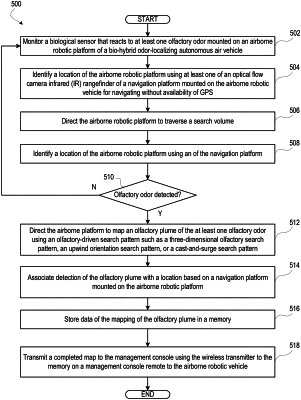| CPC G05D 1/0274 (2013.01) [B64C 39/024 (2013.01); B64C 39/028 (2013.01); G05D 1/0038 (2013.01); G05D 1/0044 (2013.01); H04W 4/40 (2018.02); B64C 2201/127 (2013.01)] | 18 Claims |

|
1. A bio-hybrid odor-localizing autonomous air vehicle comprising:
an airborne robotic platform, wherein airborne robotic platform comprises a drone copter having at least one rudder airfoil fixed to at least one rear motor mount that passively directs the drone copter in an upwind direction;
a navigation platform coupled to the airborne robotic platform;
a biological sensor mounted on the airborne robotic platform that reacts to at least one olfactory odor, wherein the biological sensor comprises an isolated, excised moth antenna;
a controller communicatively coupled to the airborne robotic platform, the navigation platform, and the biological sensor, and which:
monitors the biological sensor;
in response to the biological sensor detecting the at least one olfactory odor, directs the airborne platform to map an olfactory plume of the at least one olfactory odor using an olfactory-driven search pattern.
|